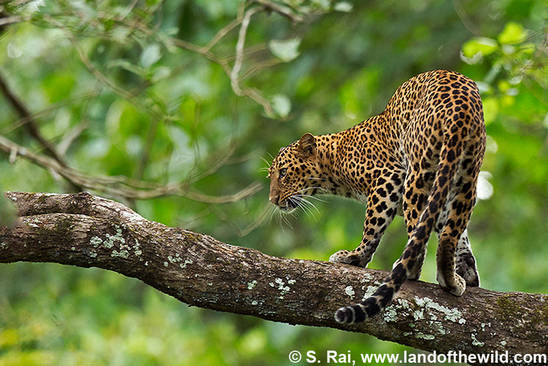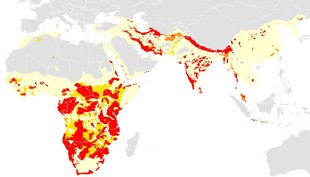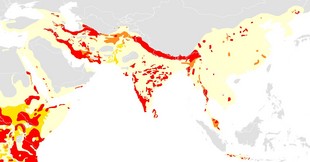Leopard
Panthera pardus
IUCN Red List: Vulnerable
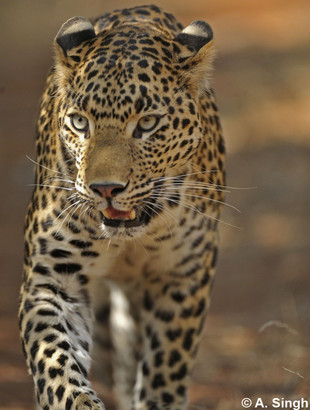
- Persian leopard (Panthera pardus saxicolor)
| Weight: | 17-90 kg |
| Body length: | 91-191 cm |
| Tail length: | 51-101 cm |
| Longevity: | 13-21 years |
| Litter size: | 1-4 cubs |
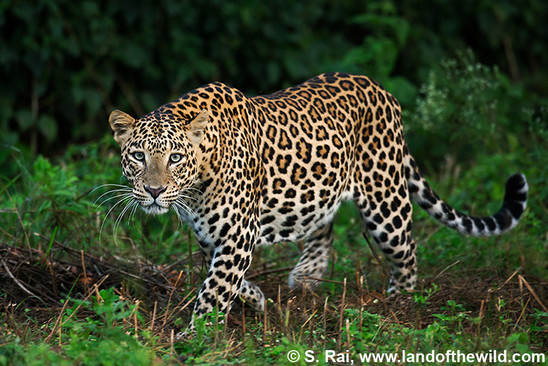
- (Panthera pardus fusca)
Description
Previously nine leopard (Panthera pardus) subspecies were described:
- African leopard P. p. pardus occurring in Africa
- Arabian leopard P. p. nimr inhabiting Arabia
- Persian leopard P. p. saxicolor from Central Asia
- Javan leopard P. p. melas occurring in Java
- Sri Lankan leopard P. p. kotiya from Sri Lanka
- Indian leopard P. p. fusca inhabiting the Indian subcontinent
- Indochinese leopard P. p. delacouri occurring from southeast Asia into southern China
- North China leopard P. p. japonensis from northern China and
- Amur leopard P. p. orientalis described from the Russian Far East, Korean peninsula and northeastern China.H
However, based on more recent genetic studies, only eight leopard subspecies are proposed:
- Panthera pardus pardus in Africa
- Panthera pardus tulliana, including cicsaucasica and saxicolor, in Turkey, Caucasus, Turkmenistan, Uzbekistan, Iran, Iraq, Afghanistan and Pakistan
- Panthera pardus fusca in India
- Panthera pardus kotiya in Sri Lanka
- Panthera pardus delacouri in South-East Asia and probably southern China
- Panthera pardus orientalis, including japonensis, in Eastern Asia from the Russian Far East to China
- Panthera pardus melas on Java and
- Panthera pardus nimr on the Arabian Peninsula
Nevertheless, more sampling throughout the leopard's range and analyses are needed to clarify the number of subspecies as some results for example indicate that all Asian subspecies, excluding melas, possibly form one single subspecies.
There is a high degree of variation in size and colouring of leopards across its broad geographical range. Leopards in Africa are typically the largest and can weigh up to 90kg; but also in the mountains of Iran and Central Asia they can attain especially large sizes. Leopards from the Arabian Peninsula are of small average size (generally only weighting around 25 kg) and are pale in colour. Usually, the leopard’s fur is yellowish to olive, and black spotted overall with individually unique patterns. In humid forest habitats, as in Java and Malaysia, melanism is quite common. Melanistic individuals have also been reported from the forests of the western coast of India and north east India. Leopards in Central Asia are often referred to as “snow leopards” in local parlance because of their light colour and long-haired winter coat.
The leopard has very muscular and relatively short legs with broad paws. It has a long body and tail which helps in tree climbing. The sexes show marked differences in size and physical features which indicates different feeding ecology. Despite its relatively small body size, the leopard is still capable of taking large prey. Its skull is massive, giving ample room for the attachment of powerful jaw muscles. Its whiskers are particularly long and there are often several extra-long hairs in the eyebrows, protecting the eyes and assisting movement through vegetation in darkness. Its scapula is adapted for the attachment of powerful muscles that raise the thorax, enhancing its ability to climb trees. The leopard can live independent of water for periods of time, satifying moisture requirements entirely from prey.
Language/Country | Name |
|---|---|
Abkhazian | alym |
Afghanistan | prang, pal |
Arabic | nimr |
Armenian | anzariuts, indz, hovaz |
English | panther, leopard |
French | léopard, panthère |
Georgia | jiki |
German | Leopard, Panther |
Hindi | Tendua |
Iran (Farsi) | palang |
Israel | namer |
Kurdish | pling |
Russian | bars |
Spanish | leopardo, pantera |
Turkey | pars, kaplan, panter |
Uzbek | koplon |
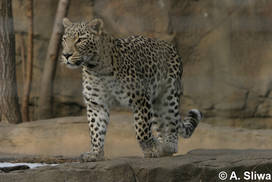
- Persian leopard (Panthera p. saxicolor).
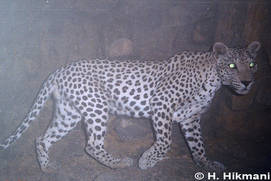
- Arabian leopard (Panthera p. nimr).
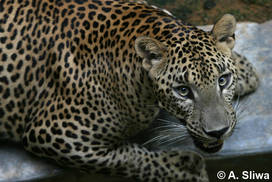
- Sri Lankan leopard (Panthera p. kotiya).
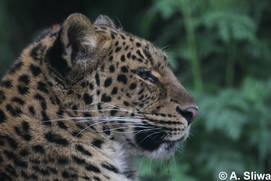
- North China leopard (Panthera p. japonensis).
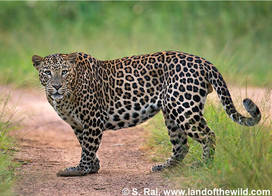
- Indian leopard (Panthera p. fusca).
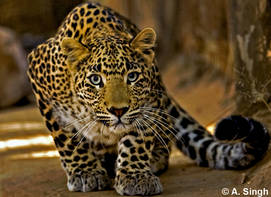
- Indian leopard (Panthera p. fusca).
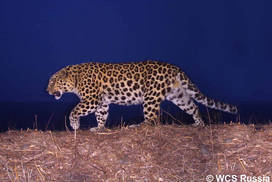
- Amur leopard (Panthera p. orientalis)
Status and Distribution
The leopard is considered Vulnerable in the IUCN Red List. The leopard`s geographic range is quite wide. It inhabits Africa and Asia and ranges from most of sub-Saharan Africa over the Arabic peninsula, south-western and eastern Turkey, through southwest Asia and the Caucasus up to the Himalayas, South Asia, Indochina, Peninsular Malaysia, China and the Russian Far East. It occurs also on the islands of Java and Sri Lanka.
In some areas of Africa and tropical Asia the leopard is locally quite common. However, its populations have decreased and got isolated in many regions and the leopard vanished from large parts of its historic range. Mainly across North, East and West Africa, the Middle East, East and South-east Asia, the species highly declined and got regionally extinct due to habitat loss and fargmentation, prey loss and poaching for the illegal wildlife trade. Leopards seem to have a wide distribution in Iran. There are some few records of the species from Iraq and Turkey in the mountains of Kurdistan and a small population was confirmed in the Zangezur Ridge, Armenia and Azerbaijan. Leopards are widespread across India and Sri Lanka. In South-east and East Asia the leopard's range has been highly reduced by more than 80% since 2008. The North China Leopard is now restricted to small, isolated protected areas in Central China. Only small fragmented populations remain in some protected areas in Cambodia, southern China, Malaysia, Myanmar and Thailand. The leopard is now possibly exinct in Gambia, Israel, Korea, Lao PDR, Lesotho, Tajikistan and Viet Nam and regionally extinct in Jordan, Kuwait, Lebanon, Mauritania, Morocco, Singapore, Syria, Togo, Tunisia, United Arab Emirates and Uzbekistan.
Subspecies | estimated population size |
|---|---|
Amur leopard | <60 |
Arabian leopard | 45-200 |
Javan leopard | <250 |
Sri Lankan leopard | 700-950 |
Persian leopard | 800-1,000 |
North China Leopard | <500, subpopulations <50 |
Country/Region | |
India (except northeast) | 7,910, national total 12,000-14,000 |
South-east Asia | < 2,500 |
Leopard density varies with prey availability, habitat type, and threat presence and intensity. The density can range from 1/100 km² to over 30/100 km².
Habitat
The leopard is highly adaptable and can inhabit a wide range of different ecosystems with extreme variation in conditions and habitat types. It occurs from tropical rainforest to temperate deciduous and alpine areas up to high mountain slopes, and is also found in savannahs, bushland, dry scrub, grasslands and deserts. In Iran and the Caucasus, pine forest and Mediterranean scrub are also suitable habitats. On the Indian subcontinent, the leopard occurs in various habitats such as forests, tea gardens, rocky outcrops, dry forests and human used landscapes. In southwest and central Asia, leopards are nowadays restricted to remote mountain areas and rugged foothill regions.
In Turkmenistan, the leopard has been recorded up to 1800 m, in Saudi Arabia up to 2,600 m, in Iran up to 3,200 m, and in the Himalaya even up to 5,200 m.
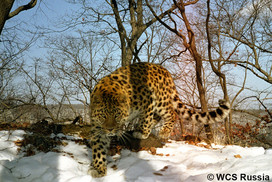
- Amur leopard habitat.
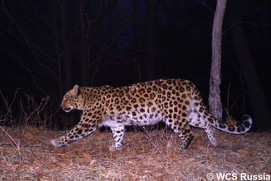
- Amur leopard.
Ecology and Behaviour
The leopard is solitary and territorial but an adult female is usually always accompanied by cubs who disperse after 2 - 3 years of age. Leopards are mainly active between sunset and sunrise and use scent marks and vocalization to communicate. The leopard is a visual hunter and uses high points such as trees to locate prey. The leopard hunts by stalking from a very low position with long periods of time resting motionless if needed. It attacks from very close range with a short burst of speed and a powerful strike of the front paw. The leopard is an excellent climber and prey is often dragged up into trees for eating and caching. This behaviour seems to be more common in areas where competing carnivores are numerous. The leopard also retreats up a tree in the face of direct aggression from such competitors.
In Thailand, the home range of a female was 8.8 km² and 17.3-18 km² for two adult males. Another study in Thailand revealed mean home ranges of 26 +/- 8.2 km² for six females and 45.7 +/- 14.8 km² for two males. In the Royal Bardia National Park in Nepal, two males ranged over 47 and 48 km² and a female over 17 km². In human dominated landscapes of India, two adult females had home ranges of 8 and 11 km² and a sub adult male had a home range of 15 km².
Reproduction may take place throughout the year. In Asia, however, the reproduction is seasonal expect for the tropics. In north-eastern Iran, the mating season starts in mid-January and peaks in mid-February. Estrus averages 7 days, the estrus cycle lasts for around 46 days and the gestation for 90-105 days. The interbirth interval averages 15 months, but can last over 2 years. Age at independence is 12-18 months. Siblings may remain together for several months before separating. The age at first reproduction for females is on average 35 months and 2-3 years for males. The age at the last reproduction is on average 8.5 years. The sex ratio of resident adults is approximately 1male:1.8 females. Cub mortality is quite high at around 41% in the first year.
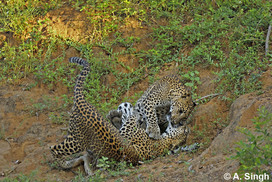
- Indian leopard (P. p. fusca)
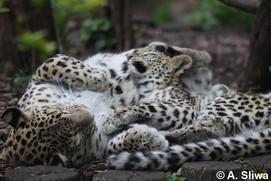
- Persian leopards (P. p. saxicolor) in Budapest Zoo.
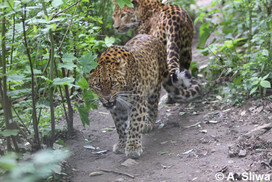
- North China leopard (P. p. japonensis)
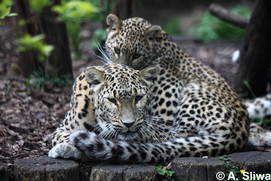
- Persian leopards (P. p. saxicolor) in Budapest Zoo.
Prey
The leopard preys on a variety of species. However, it prefers medium sized ungulates and can kill prey up to 2 or 3 times larger than itself. Muntjac, chital deer, mountain goats, roe and sika deer, hog deer, tufted deer and langur make part of its major prey species. In tropical forest, arboreal animals are taken too. Small prey is mostly taken opportunistically. However, primates, hares, rodents, large birds and small carnivores can form an important part of its diet, usually where large ungulates are less frequent. In Israel’s Judean Desert leopards seem to prey mainly on rock hyrax, ibex and porcupine. In Oman, ibex, hyrax and the Arabian red-legged partridge were reported as principal prey species. The Arabian leopard seems to take mostly small to medium sized prey such as gazelles, rock hyrax, hares, birds, lizards and insects. In northern Iran, wild pigs are reported as the major prey, and in the Caucasus Mountains, leopards are believed to prey mainly on wild goats and mouflon. In Thailand, the most important prey species were hog badger (Arctonyx collaris), muntjac (Muntiacus muntjak) and wild pig (Sus scrofa).
The diet consists of medium sized deer, primates, livestock and other domestic animals such as dogs, cats and pigs. The high density of livestock in India provides a good prey base for leopards in human used landscapes.
The leopard’s ability to use trees for caching surplus meat enables them to live close to lions and tigers and to withstand pressure from scavengers.
Main Threats
The main threats to the leopard in Asia are habitat loss and fragmentation, illegal killing for the wildlife trade and as retaliation due to conflict with humans and prey base depletion.
Habitat loss and fragmentation is mainly caused by deforestation. Habitat is primarily converted into palm oil and rubber plantations. The deforestation rate in South-east Asia is the highest of all tropical regions and is still increasing. Deforestation is closely associated with prey depletion and high levels of human disturbance. Reduced prey base is negatively affecting the leopard. In Asia leopard prey species are also under threat of regional extinction throughout tropical forests due to extensive poaching. In intact rainforest, the major threat is probably competition with humans for prey.
The fur trade was a major threat to the leopard in some areas during the 1960s and 1970s, before the market collapsed due to changing public opinion and the imposition of international trade controls under CITES. However, the leopard is still subject of illegal hunting. Targeted poaching for wildlife trade is probably the greatest factor that contributed to the recent range collapse of leopards in South-east Asia. Leopards get killed not only for their skins but also for other body parts which are used medicinal in eastern cultures. Leopard parts are used as substitutes for tiger parts for medicinal purposes in China and South-east Asia. Leopard skins are highly sought as luxury items reaching prices up to $3,000. In India, the illegal trade in leopard body parts, and the human-leopard conflict are both serious problems and the cause of significant mortalities. Poaching of leopards for the wildlife trade is increasing and around 4 leopards per week were poached in India. Illegal trade of leopard parts was comparable to that of tigers in Asian range states. This trade can have significant impacts on local leopard populations.
A rapidly increasing threat is also the poisoning of carcasses either as means of predator control or incidentally. The leopard is particularly vulnerable to baited trapping as it patrols small home ranges along regularly used trails. An assessment of mortalities of Persian leopards in Iran showed that 70% of the animals died due to hunting and poisoning. In Iraq, recent records indicate that leopards are removed at unsustainable levels.
Disease can also threaten the leopard. For example for the Amur leopard with its small population size, a disease outbreak could significantly affect the population or even lead to extinction.
Conservation Efforts and Protection Status
The leopard is included into the Appendix I of CITES. It is largely protected across its range. Hunting is prohibited or restricted to "problem" animals in Armenia, Georgia, Iran, Israel, Jordan, Pakistan, Russia, Saudi Arabia, Oman, Turkmenistan and Uzbekistan. The legal international traffic is limited to an annual quota for export of sport hunting skins and trophies. There is no legal protection in Lebanon, Tunisia, Turkey and United Arab Emirates. No information is available for Azerbaijan, Iraq, Libya, Kuwait, Syria, Tajikistan and Yemen. In Afghanistan, the leopard is protected (hunting and trading prohibited) and has recently been placed on the country's Protected Species List.
The reduction of human-leopard conflict, for example by improved livestock management measures, swiftly dispensed compensation procedures for lost livestock, is of high importance. Translocation of problem animals in order to mitigate "conflict" does not seem to be a suitable mitigation of such conflicts and has seen to increase attacks on humans. Therefore, it is not recommended. In West Asia, protected areas are too small to support viable leopard populations. Leopards are extremely adaptable species but to increase their range, it is important that ecological and social carrying capacity is increased.
Especially in Indo-Malaya and China, better protection from illegal trade should be addressed. There is a lack in information for some of the leopard subspecies such as for P. p. delacouri. It is important to get more information on these subspecies to be able to prioritize conservation measures.
Throughout its range it is important to reduce human-leopard conflict and to raise public awareness, involve local inhabitants and establish protected areas to ensure survival of the leopard. Some conservation plans are underway such as the one for the endangered Arabian or Caucasus leopard and measures to reduce human-leopard conflict are taking place.Leopard population recovery effors are currently under way with reintroduciton projects in Sochi, Greater Caucasus and the Russian far East. Nonetheless, there is still a lot to do to assure the long-term protection of the leopard throughout its range. The reduced leopard population in Arabia, for example, requires immediate action to avoid further losses or even extinction as numbers are decreasing drastically.
Recent work in India indicates that some communities revere leopards in the form of a large cat deity called waghoba or waghro.
